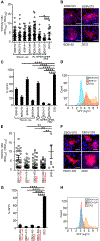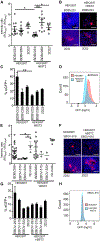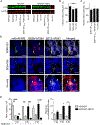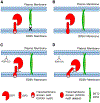Blocking of ebolavirus spread through intercellular connections by an MPER-specific antibody depends on BST2/tetherin
- PMID: 37858466
- PMCID: PMC10664807
- DOI: 10.1016/j.celrep.2023.113254
Blocking of ebolavirus spread through intercellular connections by an MPER-specific antibody depends on BST2/tetherin
Abstract
Ebola virus (EBOV) and Bundibugyo virus (BDBV) belong to the family Filoviridae and cause a severe disease in humans. We previously isolated a large panel of monoclonal antibodies from B cells of human survivors from the 2007 Uganda BDBV outbreak, 16 survivors from the 2014 EBOV outbreak in the Democratic Republic of the Congo, and one survivor from the West African 2013-2016 EBOV epidemic. Here, we demonstrate that EBOV and BDBV are capable of spreading to neighboring cells through intercellular connections in a process that depends upon actin and T cell immunoglobulin and mucin 1 protein. We quantify spread through intercellular connections by immunofluorescence microscopy and flow cytometry. One of the antibodies, BDBV223, specific to the membrane-proximal external region, induces virus accumulation at the plasma membrane. The inhibiting activity of BDBV223 depends on BST2/tetherin.
Keywords: BST2; CP: Immunology; CP: Microbiology; Ebola virus; MPER; TIM-1; cell-to-cell transmission; intercellular connections; monoclonal antibodies; tetherin; virus egress.
Copyright © 2023 The Authors. Published by Elsevier Inc. All rights reserved.
Conflict of interest statement
Declaration of interests The authors declare no competing interests.
Figures







Similar articles
-
Ferrets Infected with Bundibugyo Virus or Ebola Virus Recapitulate Important Aspects of Human Filovirus Disease.J Virol. 2016 Sep 29;90(20):9209-23. doi: 10.1128/JVI.01033-16. Print 2016 Oct 15. J Virol. 2016. PMID: 27489269 Free PMC article.
-
Antibody-Mediated Protective Mechanisms Induced by a Trivalent Parainfluenza Virus-Vectored Ebolavirus Vaccine.J Virol. 2019 Feb 5;93(4):e01845-18. doi: 10.1128/JVI.01845-18. Print 2019 Feb 15. J Virol. 2019. PMID: 30518655 Free PMC article.
-
The Tetherin Antagonism of the Ebola Virus Glycoprotein Requires an Intact Receptor-Binding Domain and Can Be Blocked by GP1-Specific Antibodies.J Virol. 2016 Nov 28;90(24):11075-11086. doi: 10.1128/JVI.01563-16. Print 2016 Dec 15. J Virol. 2016. PMID: 27707924 Free PMC article.
-
Comprehensive Review on Ebola (EBOV) Virus: Future Prospects.Infect Disord Drug Targets. 2018;18(2):96-104. doi: 10.2174/1871526517666170817100828. Infect Disord Drug Targets. 2018. PMID: 28820067 Review.
-
Review: Insights on Current FDA-Approved Monoclonal Antibodies Against Ebola Virus Infection.Front Immunol. 2021 Aug 30;12:721328. doi: 10.3389/fimmu.2021.721328. eCollection 2021. Front Immunol. 2021. PMID: 34526994 Free PMC article. Review.
Cited by
-
Antibodies targeting the glycan cap of Ebola virus glycoprotein are potent inducers of the complement system.Commun Biol. 2024 Jul 17;7(1):871. doi: 10.1038/s42003-024-06556-0. Commun Biol. 2024. PMID: 39020082 Free PMC article.
-
Protocol for quantification of intercellular connection transmission in ebolavirus infections using ImageJ.STAR Protoc. 2024 Dec 20;5(4):103363. doi: 10.1016/j.xpro.2024.103363. Epub 2024 Oct 5. STAR Protoc. 2024. PMID: 39369387 Free PMC article.
References
-
- Goldstein T, Anthony SJ, Gbakima A, Bird BH, Bangura J, Tremeau-Bravard A, Belaganahalli MN, Wells HL, Dhanota JK, Liang E, et al. (2018). The discovery of Bombali virus adds further support for bats as hosts of ebolaviruses. Nat. Microbiol. 3, 1084–1089. 10.1038/s41564-018-0227-2. - DOI - PMC - PubMed
Publication types
MeSH terms
Substances
Grants and funding
LinkOut - more resources
Full Text Sources
Medical
Research Materials
Miscellaneous

